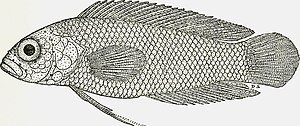Pseudoplesiopinae
| Pseudoplesiopinae | ||||||||||||
|---|---|---|---|---|---|---|---|---|---|---|---|---|

Pseudoplesiops typus |
||||||||||||
| Systematics | ||||||||||||
|
||||||||||||
| Scientific name | ||||||||||||
| Pseudoplesiopinae | ||||||||||||
| Bleeker , 1875 | ||||||||||||
The Pseudoplesiopinae are a group of small marine fish found on the coasts of the tropical Indo-Pacific . They form a subfamily within the family of the dwarf perch (Pseudochromidae).
features
The Pseudoplesiopinae are very small fish and reach a length of 2.3 to 6 centimeters, depending on the species. Her head is scaled, her palatal bone is dentate. Most of the dorsal rays are simple. The pelvic fins are supported by a fin spine and three or four soft rays, the pectoral fins have 17 to 19 fin rays. The Pseudoplesiopinae differ from the three other subfamilies of the dwarf perch , among other things, by their lateral line scales with only one pore in front . Your Urohyale, a tendon ossification in the skull , has a noticeable upward protrusion. The basihyale, an element between the hyoid bones , is connected to the anterior surface of the first basibranchial (bone at the base of the first branchial arch ). The coracoid steers on the abdomen with the middle surface of the lateral lamella of the cleithrum . The base of the anterior pelvic outgrowth is relatively far back. The rear part of the pelvic bones has a lateral triangular or hook-shaped outgrowth.
Genera and species
|
There are five genera and almost 30 species:
- Genus Amsichthys Gill & Edwards, 1999
- Amsichthys knighti (Allen 1987)
- Genus Chlidichthys Smith, 1953
- Chlidichthys abruptus Lubbock, 1977
- Chlidichthys auratus Lubbock, 1975
- Chlidichthys bibulus (Smith, 1954)
- Chlidichthys cacatuoides Gill & Randall, 1994
- Chlidichthys chagosensis Gill & Edwards, 2004
- Chlidichthys clibanarius Gill & Edwards, 2004
- Chlidichthys foudioides Gill & Edwards, 2004
- Chlidichthys inornatus Lubbock, 1976
- Chlidichthys johnvoelckeri Smith, 1953
- Chlidichthys pembae Smith, 1954
- Chlidichthys randalli Lubbock, 1977
- Chlidichthys rubiceps Lubbock, 1975
- Chlidichthys smithae Lubbock, 1977
- Genus Lubbockichthys Gill & Edwards, 1999
- Lubbockichthys multisquamatus (Allen, 1987)
- Lubbockichthys myersi Gill & Edwards, 2006
- Lubbockichthys tanakai Gill & Senou, 2002
- Genus Pectinochromis Gill & Edwards, 1999
- Pectinochromis lubbocki (Edwards & Randall 1983)
- Genus Pseudoplesiops Bleeker, 1858
- Pseudoplesiops annae (Weber, 1913)
- Pseudoplesiops collare Gill, Randall & Edwards, 1991
- Pseudoplesiops howensis Allen, 1987
- Pseudoplesiops immaculatus Gill & Edwards, 2002
- Pseudoplesiops knighti Allen, 1987
- Pseudoplesiops occidentalis Gill & Edwards, 2002
- Pseudoplesiops revellei Schultz, 1953
- Pseudoplesiops rosae Schultz, 1943
- Pseudoplesiops typus Bleeker, 1858
- Pseudoplesiops wassi Gill & Edwards, 2003
literature
- Joseph S. Nelson : Fishes of the World. 4th edition. John Wiley & Sons, Hoboken NJ et al. 2006, ISBN 0-471-25031-7 .
- Anthony C. Gill & Alasdair J. Edwards: Monophyly, Interrelationships and Description of Three New Genera in the Dottyback Fish Subfamily Pseudoplesiopinae (Teleostei: Perciformes: Pseudochromidae). Records of the Australian Museum (1999) Vol. 51: 141-160. ISSN 0067-1975
Web links
- Alasdair Edwards, Tony Gill: Systematics and phylogeny of pseudoplesiopine dottyback fishes (Pseudochromidae). on-line
- Pseudoplesiopinae on Fishbase.org (English)